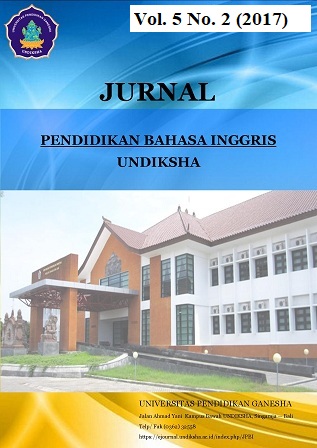Politeness Strategies Used by the Second-Grade Students at SDN 1 Pemaron
DOI:
https://doi.org/10.23887/jpbi.v5i2.12402Abstract
Penelitian ini bertujuan untuk mengidentifikasi tipe-tipe maksim kesopanan yang digunakan dan mendeskripsikan penggunaan maksim kesopanan oleh siswa-siswi kelas dua di SDN 1 Pemaron. Penelitian ini merupakan penelitian deskriptif kualitatif. Hasil penelitian menunjukkan bahwa terdapat enam tipe maksim kesopanan yang di gunkan oleh siswa-siswi kelas dua di SDN 1 Pemaron. Selanjutnya, tipe maksim kesopanan yang paling sering di gunakan oleh siswa-siswi kelas dua di SDN 1 Pemaron adalah maksim pemufakatan/kecocokan dimana muncul sebanyak 53 kali (35%). Tipe yang kedua adalah maksim kesederhanaan yang muncul sebanyak 40 kali (27%). Tipe maksim yang ketiga adalah maksim kesimpatian yang muncul sebanyak 19 kali (13%). Tipe maksim yang keempat adalah maksim kedermawanan yang muncul sebanyak 18 kali (12%). Tipe maksim yang kelima adalah maksim kebijaksanaan yang muncul sebanyak 12 kali (8%). Tipe maksim yang terakhir adalah maksim penghargaan yang muncul sebanyak 8 kali (5%). Maksim tersebut digunakan untuk memaksimalkan persetujuan dengan lawan bicaranya terlebih dahulu sebelum mengungkapkan perasaan atau opini mereka, menunjukkan rasa rendah hati ketika mereka berbuat kesalahan atau tidak bisa melakukan sesuatu yang di minta, menunjukkan rasa peduli dan simpati, menunjukkan keramahan mereka, untuk membuat teman mereka diam ketika mereka membuat kesalahan atau masalah, dan untuk memuji temannya sebelum mereka meminta bantuan.Kata Kunci : Maksim Kesopanan, Siswa-siswi kelas dua, Strategi Kesopanan.
This study aimed at identifying types of politeness maxim use and describe the use of politeness maxim by the second-grade students in SDN 1 Pemaron. This study is descriptive qualitative research. The results of this study reveals that there are six types of politeness maxim used by second-grade students in SDN 1 Pemaron. Then the most frequently used type of politeness maxim by second-grade students in SDN 1 Pemaron was agreement maxim which occurred 53 times (35%). The second type was modesty maxim which occurred 40 times (27%). The third type was sympathy maxim which occurred 19 times (13%). The fourth type was generosity maxim which occurred 18 times (12%). The fifth type was tact maxim which occurred 12 times (8%). The last type was approbation maxim which occurred 8 times (5%). Those maxims use for maximize the agreement between the interlocutor first before revealed their feeling or opinion, dispraise themselves when they make a mistake or cannot do something that have been told, show their care and sympathy, show their friendliness, to make their friends keep silent when they made a mistake or problem and to praise their friends before asked for a help.
keyword : Politeness Maxims, Politeness Strategies, Second-grade Students.
Published
2017-10-27
Issue
Section
Articles
License
Authors who publish with the Jurnal Pendidikan Bahasa Inggris Undiksha agree to the following terms:- Authors retain copyright and grant the journal the right of first publication with the work simultaneously licensed under a Creative Commons Attribution License (CC BY-SA 4.0) that allows others to share the work with an acknowledgment of the work's authorship and initial publication in this journal
- Authors are able to enter into separate, additional contractual arrangements for the non-exclusive distribution of the journal's published version of the work (e.g., post it to an institutional repository or publish it in a book), with an acknowledgment of its initial publication in this journal.
- Authors are permitted and encouraged to post their work online (e.g., in institutional repositories or on their website) prior to and during the submission process, as it can lead to productive exchanges, as well as earlier and greater citation of published work. (See The Effect of Open Access)













